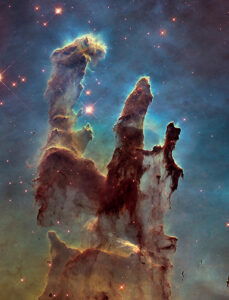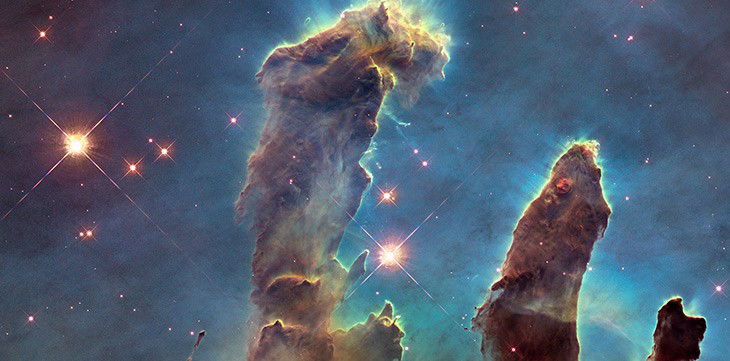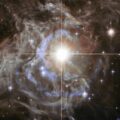NASA has released a three-dimensional multi-wavelength movie of the star-forming region known as the “Pillars of Creation.” Compiled from data gathered by the James Webb Space Telescope, the Hubble Space Telescope, the Spitzer Space Telescope, and the Chandra X-Ray observatory, NASA describes the nearly five-minute visualization as “the most comprehensive and detailed multiwavelength movie yet” of this area of space.
“By flying past and amongst the pillars, viewers experience their three-dimensional structure and see how they look different in the Hubble visible-light view versus the Webb infrared light view,” explained principal visualization scientist and leader of the video development team Frank Summers of the Space Telescope Science Institute (STScI) in Baltimore. “The contrast helps them understand why we have more than one space telescope to observe different aspects of the same object.”
Largest Pillars of Creation Span Three Light Years
Located at the center of an area of space known as M16, or the Eagle Nebula, the Pillars of Creation are massive clouds of cool molecular hydrogen mixed with dust where new stars form. This massive stellar nursery came to fame in 1995 when Hubble sent back the first stunning images of the region captured by its Wide-Field Planetary Camera 2. A newer version of the camera installed on Hubble took even more detailed photos in 2014, further capturing the public’s imagination.


According to NASA’s announcement of the new video, the longest of the Pillars stretches across three light years. For comparison, there are four light-years between the Sun and its nearest stellar neighbor, Proxima Centauri. NASA also notes that the pillars are being slowly ripped apart by the “fierce winds and ultraviolet light” coming from nearby hot, young stars. In fact, recent images gathered from the JWST revealed embryonic stars embedded in the solar system-sized finger-like structures emanating from the tops of the pillars.
Now, NASA says it has combined all of the data taken from these observatories to create this 3D movie in hopes of inspiring awe and curiosity about the accelerating pace of discovery happening in the modern space age.
Data-Based 3D “Visualization,” Not an Artist’s Interpretation
To create the visual marvel, members of NASA’s Universe of Learning tapped into real astronomical data instead of asking an artist to recreate the Pillars from just images. A partnership among the STScI, Caltech/IPAC, the Center for Astrophysics Harvard & Smithsonian, and the Jet Propulsion Laboratory, the group relied on a compilation of actual observational data published by Anna McLeod, an associate professor at the University of Durham in the United Kingdom, and colleagues.
For example, NASA points out that Hubble records data in the visual light spectrum “up to thousands of degrees.” According to the space agency, this capability accounts for the popularity of the images of the Pillars of Creation captured by the observatory. In contrast, the JWST studied the Pillars using one of its infrared instruments, which NASA says “is sensitive to cooler objects with temperatures of just hundreds of degrees.” As noted, this unprecedented level of sensitivity allowed the JWST to peer through the cloud of dust to image the newborn stars hidden inside.
The data captured from the Spitzer Telescope is also infrared, while the data from Chandra is in the X-ray spectrum. By combining all of these spectral data sets along with Hubble’s visible light images, NASA has created a 3D visualization that gives viewers an unprecedented view of this impressive region of space.
“The 3D structures are approximations for how the pillars are lined up in space like a row of trees, based on observational data,” the space agency explains. “The goal is to give viewers an experiential view so that they can better interpret the otherwise flat, two-dimensional images from telescopes. This 3D understanding allowed the team to create 3D printable files of the Pillars using the newest data.”
Christopher Plain is a Science Fiction and Fantasy novelist and Head Science Writer at The Debrief. Follow and connect with him on X, learn about his books at plainfiction.com, or email him directly at christopher@thedebrief.org.

